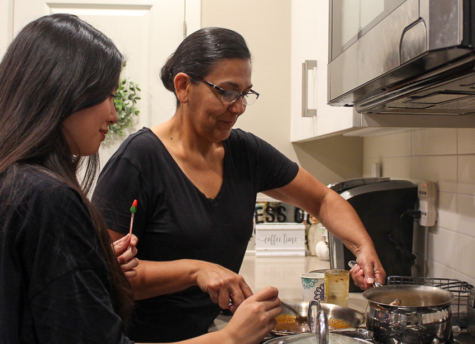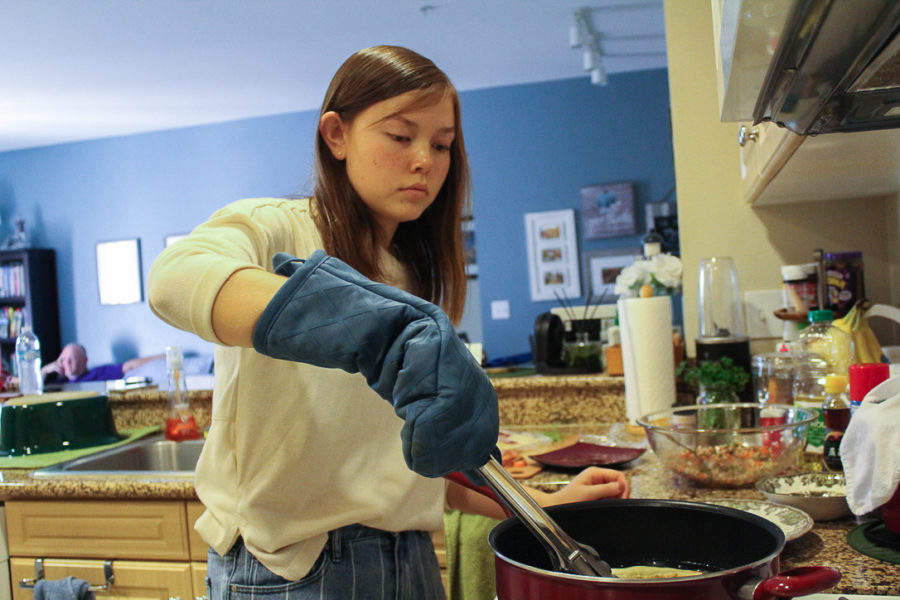Serving Recipes from the Melting Pot
Like a switch has flipped, the energy of stressed, sleep-deprived students replenishes as the year transitions into the distinct season of nippy weather, frequent breaks, preliminary Christmas music streaming and feel-good holiday cuisine. The reemergence of nostalgia feeds the collective excitement that builds around Thanksgiving time.
Living in the city of Irvine vastly diversifies the modes of holiday celebration, especially in homes that harbor more than one cultural background. From one plate to another and one language to the next, gratitude takes on multiple forms.
The Siribandans’ Pollo en Mole:
Junior Kaelene Siribandan twirls a chili-coated lollipop in her left hand as she forks through a steaming pot of red-tinged rice with the right, following the guiding head nods of her mother who narrates the steps aloud. Now an easily-achieved dinner on a winter weeknight, mole initially took root in the Siribandan family history as a special treat.
“Growing up, my mom’s family didn’t have a lot of money,” Siribandan said. “They lived in the projects in L.A. They had a lot of mouths to feed. Sometimes, recipes like mole weren’t always the first option. They were most of the time for special occasions, which contributes to why they’re more special now.”

As junior Kaelene Siribandan and her mother cook, they recount embarrassing stories, favorite moments and how much Kaelena has changed.
As a multiethnic teenager living in the predominantly Asian influences of Irvine, reunions at annual holiday gatherings with her abundant extended family are her opportunities to explore her Hispanic heritage.
“My ethnicity plays a large role in my life, being mixed,” Siribandan said. “I’m Chinese and Mexican and also Thai. Since me and my brother are part Asian, it sets us kind of differently with the rest of the family, given that they’re more in touch with their Hispanic side sometimes. So whenever we visit, my family loves to tell different stories of my grandma and things that happened throughout their childhood. It helps me feel like I’m still connected to her in some way and that her spirit lives on in my mom and my cousins.”
Through the strength of love and familial bonds, Siribandan can connect with these unlived memories and be able to envision them with a richness akin to the deep, cocoa-brown mole sauce that smothers the chicken and rice.
“It makes me feel good to know that my kids can share this with me and that they enjoy it and embrace the Mexican side of their culture,” Kaelene’s mother Anita Siribandan said. “It’s almost like — even though you didn’t grow up with [something] completely, there’s still something inside of you that comes out and enjoys it.”
Although Kaelene Siribandan anticipates much more to learn as she continues to foster her Hispanic identity, she said she enjoys flaunting the elements she currently partakes in.
“I love to introduce my friends to different Mexican candies and desserts and ice creams or even share my favorite Mexican songs,” Kaelene Siribandan said. “It makes me feel proud, not only that I got to show them something they never experienced before, but that other people can learn more about my culture and some of my favorite things as well. I’m happy that I can be a pathway for other people to experience new things.”
Recipe:
7 chicken thighs, cubed
1 jar of Doña María mole paste (can be found in the Mexican cooking aisle at most grocery stores)
2 tablespoons chicken bouillon
1 tablespoon garlic powder
1 teaspoon pepper
- Add bouillon, garlic powder and pepper to a medium-sized pot of water at a rolling boil.
- Reduce the seasoned water to low boil and cook chicken thoroughly, about 10 to 15 minutes. Be careful not to overcook, which may result in a rubbery texture.
- Add half a jar of Doña María mole to a separate pan with a cup of the chicken broth.
- Mix the mole with the broth to desired consistency. Add more broth for a thinner sauce.
- Stir the chicken into the sauce.
- Serve with Spanish rice and a blackened flour tortilla.
The DeNeves’ Lumpia:
During the holidays, the dinner table at junior Faith DeNeve’s family gatherings is a patchwork of dishes from several cultures.
“We have lumpia, which is the Filipino side,” DeNeve said, “and we have the American side, which is always mashed potatoes.”
DeNeve likens her own identity and family traditions to the expansive diversity of those of the Philippines, which she considers a dominant characteristic — a result of colonization and imperialism.
“It just shows me that it’s okay to be a mix of things,” DeNeve said. “Sometimes I feel like I’m not supposed to identify with my Filipino side because I’m [half] white, and we live in America, and I don’t really speak Tagalog. Sometimes I feel like, ‘Can I even really connect with this?’ But through food and family it shows me: ‘Yes! It’s okay to be a mix of things; that’s part of being Filipino.’”
DeNeve moves effortlessly through the process of cooking the filling and tucking the mixture into pristine rolls, a routine espoused by heart through fond childhood memories.
“I always remember cooking with my aunt and my mom and my older cousin Megan during Thanksgiving,” DeNeve said. “I really remember the two of us, me and my cousin, saying ‘Okay Tita Mimi, tell us when you’re going to be making the food because we want to help!’ It was really nice; we would tell each other what was going on in our lives. It was the way we would catch up because they live in Temecula, so we don’t see them as much as we want to.”
In understanding the sensitivity of time and the obstacle that distance often poses, DeNeve said she values the expression of gratitude even beyond her family members during the holiday season. Sharing homemade lumpia with loved ones embodies DeNeve’s faithfulness to the Filipino quality of diversity that she admires; every bonding experience is chance to embrace her culture as well as learn more about others’.

“No matter who you have a connection with, somehow they influence you, and somehow you influence them, whether we realize it or not,” DeNeve said. “It helps me become more empathetic and understanding of other people’s perspectives. In a general sense, being connected by love through things that seem so trivial like food helps make the world a better place. That sounds really cheesy, but it’s true.”
Recipe:
1 pound of ground pork
2 shallots
2 carrots
1 1/2 teaspoons garlic powder
1/2 cup parsley
1 tablespoon sesame oil
2 eggs
Salt
Pepper
Lumpia (or egg roll) wrappers (can be found in the Asian cooking aisle at most grocery stores or Asian supermarkets)
- Pre-cook the pork by pan-frying it with a neutral-flavored oil until no pinkness remains, about 10 minutes.
- Set aside in a large bowl and add finely-chopped shallots, carrots and parsley.
- Add sesame oil and season to taste with salt and pepper.
- Add one egg to the bowl and stir the filling mixture until thoroughly combined.
- Crack and whisk the second egg into a separate bowl to use as egg wash.
- Arrange a small line of the filling onto one side of the wrapper and close the seams with a brush of egg wash.
- Repeat until all of the filling is used up.
- Fry the rolls in a shallow pool of neutral oil until the wrappers are a blistered golden brown all around.
- Drain and cool on a wire rack. Serve as a side dish or appetizer.
Your donation will support the student journalists of Portola High School. Your contribution will allow us to purchase equipment and cover our annual website hosting costs.

Kelthie Truong is a Co-Managing Editor for the 2020-21 school year, her second and final year with the Pilot. When she’s not in the newsroom, you can...




